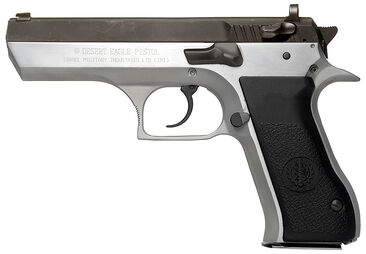
The Jericho 941 is a double action/single action semi-automatic pistol developed by Israel Military Industries (now: Israel Weapon Industries) that was launched in 1990.
The Jericho 941R was seen in Beverly Hills Cop III.
Description[]
It was first imported into the US in 1990 by K.B.I., Inc. of Harrisburg, Pennsylvania. It was later imported by O.F. Mossberg & Sons and named the Uzi Eagle and by Magnum Research, Inc. as the Baby Eagle until the end of 2008. Some pistols from Magnum Research are marked Desert Eagle Pistol. Despite these names being used in the US market, the Jericho 941 is not related to the IMI Desert Eagle other than its manufacture and design by IMI, and bears only a slight cosmetic resemblance to the larger pistol. From January 2009 until they ceased business in January 2010, K.B.I., Inc. (which also imported Charles Daly firearms) imported of the handgun as the Jericho. Magnum Research, now a division of Kahr Arms, announced a renewed importation of the Jericho. The original Jericho 941 was modeled on the well-respected CZ-75 pistol designed and produced by Česká zbrojovka (CZ) of the Czech Republic and built using parts supplied by the Italian arms house Tanfoglio, which had been making their own CZ-75 clones. Using a well-tested design allowed IMI to avoid the teething problems most new pistol designs experience, and subcontracting much of the basic fabrication work to Tanfoglio allowed IMI to quickly and economically put into production a pistol that would have enough Israeli content to satisfy government contract requirements. While the R-versions of Jericho 941 feature a combined safety/decocker, which on safe also decocks the pistol, the decocker version of CZ-75 (CZ-75BD) features only a simple de-cocker. The barrel of the CZ-75 is traditionally rifled, while the Jericho 941 features a polygonal barrel, furthermore the Jericho 941 is substantially heavier. These differences translate into substantial differences in the condition in which the gun is carried. Magazines for the CZ-75 and Tanfoglio T95 will function in the Jericho 941.
One innovation by IMI was a new, much "hotter" cartridge, the .41 Action Express (see below) to go along with the Jericho 941. The difference between 9mm and .41 AE is the same as .44 Magnum and .50 AE. The AE bullets have rebated rims which are the same diameter as the less powerful rounds, but the casing is wider, providing more power. This allows these pairs of calibers to be used in the same firearm with only a change of barrel, recoil spring and magazine. The .41 AE was less commercially successful than the 10 mm, and was soon discontinued. Experience with heavily loaded rounds gave IMI a considerable lead, however, in chambering for the soon-to-be successful .40 S&W and also allowed the Jericho to "up-chamber" to the very popular .45 ACP. The Jericho 941 design has been modified to include accessory rails on the frame for mounting lasers or flashlights, a feature found on many current-generation semi-automatic handguns. The introduction of the Jericho 941 also introduced a new caliber to the market, the .41 Action Express (or .41 AE), which was developed in 1986. The .41 AE was a unique rebated rim cartridge designed to use .410 inch (10.25 mm) bullets and duplicate a reduced power police loading of the .41 Magnum. The Jericho originally shipped with two barrels, one for 9×19mm Parabellum and the other for .41 AE. Since the .41 AE was designed with a rebated rim the same dimensions as that of the 9 mm, the extractor and ejector worked equally well for either cartridge.
Ballistically, the .40 S&W was similar to moderate .41 AE loads (the reloading manuals that list the .41 AE generally say to use .40 S&W data), although commercial loadings of .41 AE were somewhat more powerful than the .40 S&W. With the stronger backing of major American firearms and ammunition manufacturers, the .40 S&W quickly pushed the .41 AE out of the market. The Jericho 941 was only on the market for one year before the dual 9 mm/.41 AE chambering was dropped, and the pistol was sold as either 9 mm or .40 S&W. Some shooters like the Baby Eagle in .40 S&W for its extra reserve of strength, since the Baby Eagle was originally designed for a more potent cartridge (the .41 AE), which is the reverse of some makers who dropped .40 S&W barrels into pistols previously spec'd for the milder 9mm cartridge and had subsequent barrel and cartridge case failures. A later compact version, the Jericho 941, was chambered in .45 ACP or 9 mm. It is not clear to what extent the Jericho original 41. AE/9 mm Jericho frame and slide were "built-up" to handle the .45 ACP's much larger diameter; although the .45 ACP is a milder load running at much lower pressures than the .41 AE, the barrel opening for the .45 ACP is, of necessity, much larger. Desert Eagle does not permit the use of +P or +P+ loads per its website FAQ, although reviewers have shot and reported the ballistics on +P .45 ACP defensive loadings. Initially, Jericho pistols used barrels with polygonal rifling, which sometimes produces slightly higher velocity due to better bullet to barrel fit. IWI switched to conventional land and groove rifling from 2005 to 2007. The Jericho 941 is issued in current service throughout the Israeli Security Forces, and Israel Weapon Industries Lost a 1.2 Billion Pesos bid for the Philippine National Police's 60,000 handgun procurement on July 11, 2012.
